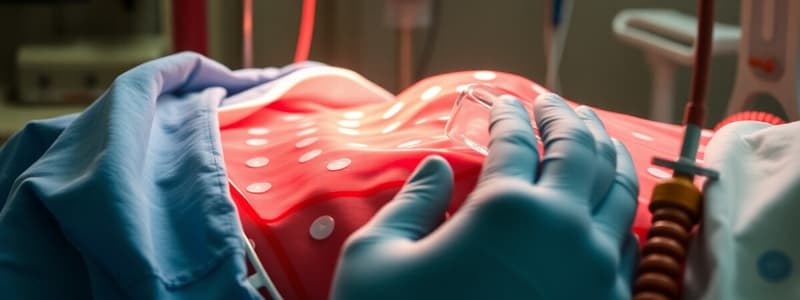Podcast
Questions and Answers
Which statement best describes the underlying mechanism of sepsis?
Which statement best describes the underlying mechanism of sepsis?
- A dysregulated host response to infection, causing widespread inflammation and tissue damage. (correct)
- A localized immune response that damages the infected tissue.
- A regulated immune response to infection, directly targeting the pathogen.
- A suppressed immune response to infection, leading to opportunistic infections.
Septic shock is characterized by persistent hypotension requiring vasopressors and a serum lactate level above what value?
Septic shock is characterized by persistent hypotension requiring vasopressors and a serum lactate level above what value?
- 1 mmol/L
- 4 mmol/L
- 3 mmol/L
- 2 mmol/L (correct)
Which vessel provides the majority of blood flow to the liver, and what is the primary characteristic of this blood?
Which vessel provides the majority of blood flow to the liver, and what is the primary characteristic of this blood?
- Hepatic artery; oxygen-rich
- Hepatic vein; oxygen-poor
- Hepatic portal vein; nutrient-rich, oxygen-poor (correct)
- Hepatic artery; nutrient-poor, oxygen-rich
The hepatic artery supplies what percentage of blood to the liver?
The hepatic artery supplies what percentage of blood to the liver?
A patient has burns on their entire left arm and the front of their trunk. Using the Rule of Nines, what is the estimated percentage of total body surface area (TBSA) burned?
A patient has burns on their entire left arm and the front of their trunk. Using the Rule of Nines, what is the estimated percentage of total body surface area (TBSA) burned?
Which burn estimation method relies on comparing the patient's palm surface area to the burned area?
Which burn estimation method relies on comparing the patient's palm surface area to the burned area?
What is a key difference between the Lund-Browder chart and the Rule of Nines in estimating burn area?
What is a key difference between the Lund-Browder chart and the Rule of Nines in estimating burn area?
Why is the Surface Area Graphic Evaluation (SAGE) method considered advantageous in burn area estimation?
Why is the Surface Area Graphic Evaluation (SAGE) method considered advantageous in burn area estimation?
Which of the following statements accurately differentiates disinfection from sterilization?
Which of the following statements accurately differentiates disinfection from sterilization?
A hospital uses a chemical agent to clean a surface, aiming to reduce the number of pathogenic organisms to a safe level. This process is best described as:
A hospital uses a chemical agent to clean a surface, aiming to reduce the number of pathogenic organisms to a safe level. This process is best described as:
What is the critical distinction between disinfection and antisepsis?
What is the critical distinction between disinfection and antisepsis?
Why is sterilization considered a more rigorous process than disinfection in healthcare settings?
Why is sterilization considered a more rigorous process than disinfection in healthcare settings?
The cystic duct directly connects which two anatomical structures?
The cystic duct directly connects which two anatomical structures?
Where does the bile, after exiting the cystic duct, ultimately drain into?
Where does the bile, after exiting the cystic duct, ultimately drain into?
What is the functional consequence of the cystic duct merging with the common hepatic duct?
What is the functional consequence of the cystic duct merging with the common hepatic duct?
What is the primary role of the common bile duct (CBD)?
What is the primary role of the common bile duct (CBD)?
If the cystic duct is blocked by a gallstone, which of the following would likely occur?
If the cystic duct is blocked by a gallstone, which of the following would likely occur?
What type of blood does the hepatic portal vein carry, and where does it originate?
What type of blood does the hepatic portal vein carry, and where does it originate?
What is a key difference between the blood supplied by the hepatic artery and the hepatic portal vein?
What is a key difference between the blood supplied by the hepatic artery and the hepatic portal vein?
What primarily happens to the blood (from the hepatic portal vein) within the liver?
What primarily happens to the blood (from the hepatic portal vein) within the liver?
Flashcards
Sepsis
Sepsis
Life-threatening condition; dysregulated host response to infection. Widespread inflammation causes tissue and organ damage
Septic Shock
Septic Shock
Severe sepsis stage; vasodilatory/distributive shock. Requires vasopressors (MAP >= 65mmHg) and lactate > 2 mmol/L.
Hepatic Portal Vein
Hepatic Portal Vein
Supplies ~75% of liver blood. Nutrient-rich, oxygen-poor blood from the small intestine.
Hepatic Artery
Hepatic Artery
Signup and view all the flashcards
Burn Area Estimation Techniques
Burn Area Estimation Techniques
Signup and view all the flashcards
Disinfection: Complete Microorganism Removal?
Disinfection: Complete Microorganism Removal?
Signup and view all the flashcards
Cystic Duct Drainage
Cystic Duct Drainage
Signup and view all the flashcards
Study Notes
- Sepsis is a life-threatening condition arising from a dysregulated host response to infection.
- This dysregulation leads to widespread inflammation, causing tissue and organ damage.
- Septic shock is the most critical stage of sepsis, characterized as a vasodilatory/distributive shock.
- Septic shock has a higher mortality risk than sepsis.
- Septic shock is defined by persistent hypotension requiring vasopressors.
- Vasopressors are needed to maintain a Mean Arterial Pressure (MAP) of >= 65mmHg.
- Septic shock also involves a serum lactate level of > 2 mmol/L.
- The hepatic portal vein delivers approximately 75% of the liver's blood supply.
- Blood from the hepatic portal vein is rich in nutrients absorbed from the small intestines.
- This blood is mostly oxygen-poor due to oxygen consumption in the small intestine.
- The hepatic artery provides the remaining 25% of blood to the liver.
- Blood from the hepatic artery is oxygen-rich, coming directly from the abdominal aorta.
- Techniques to evaluate burn area include:
- Rule of nines
- Palmar surface method
- Lund and Browder chart
- Surface Area Graphic Evaluation (SAGE)
- Disinfection does not eliminate all microorganisms, but it selectively eliminates some unwanted ones.
- Disinfection targets the structure or metabolism of microorganisms to prevent their transmission.
- Sterilization is a process that destroys all microorganisms, including intra-organisms and spores.
- The cystic duct drains into the common hepatic duct.
- The cystic duct and the common hepatic duct merge to form the common bile duct (CBD).
- Bile from the gallbladder drains through the cystic duct into the common hepatic duct.
- The liver also contributes bile to the common hepatic duct.
- Bile from both the gallbladder and liver flows through the common bile duct into the duodenum.
Studying That Suits You
Use AI to generate personalized quizzes and flashcards to suit your learning preferences.




